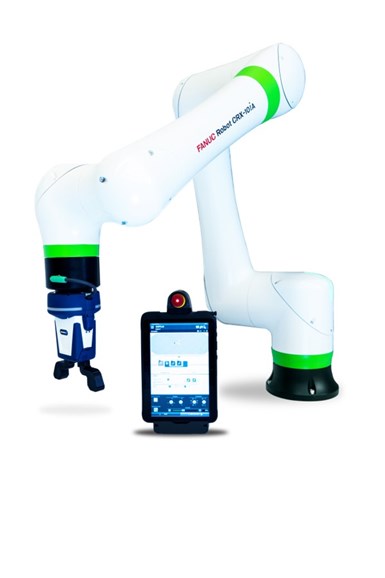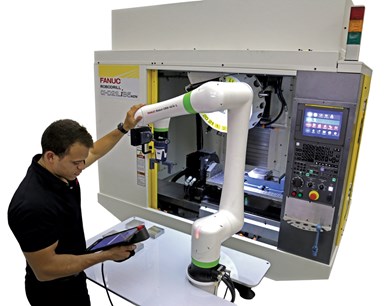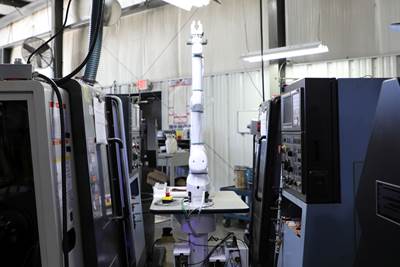Share




Autodesk, Inc.
Featured Content
View More

Hwacheon Machinery America, Inc.
Featured Content
View More

ECi Software Solutions, Inc.
Featured Content
View More
Takumi USA
Featured Content
View More
Technological advances have allowed shops to implement their own automation systems, but they’ve also blurred the line between applications a shop can DIY and those that require an integrator, increasing chances of a failed automation system.
Technological advances are making robots easier to implement. In many cases, shops have installed robots without the support of a robot integrator, but many automation systems present challenging hurdles that are too complicated for a DIY solution. The difference between successful DIY applications versus those that require an integrator isn’t always clear. The consequences of a failed integration can be costly, but if shops take the proper steps, they can avoid the pitfalls and achieve a successful robotic integration.
According to John Tuohy, an account manager at FANUC America Corporation who's responsible for the company's Authorized System Integrators group focused on robotic machine tending applications, the first step shops can take to prevent a failed system is to define their automation goals. He suggests thinking beyond just putting a robot in front of a machine. As with any tool, the goal is to optimize the use of that tool to improve quality, throughput, efficiency and ultimately, the company’s bottom line. A defined automation strategy will help shops determine what type of automation can help them reach their goals. From there, shops must answer the question of whether they can implement the robot themselves, or if they need an integrator.
D-I-Why?
Tuohy says that emphasis on ease of use over collaborative operation is a trend in the cobot space. Cobots and industrial robots are now available with a number of features that allow shops to automate simple tasks without an integrator. These features include:
- Hand guidance and icon-based programming. Users don’t need to know traditional robotic programming languages in order to teach a cobot. “It's icon-based programming, so everything is pictures, which is kind of hard to mess up,” Tuohy explains. “And even if you do mess up, you can grab the robot and put it wherever you want it and it'll remember that path.” He estimates that most shop owners could have a cobot working within 20 to 30 minutes of removing it from the box.
- Plug-and-play grippers. Grippers are an important aspect of an automation system that vary from application to application and aren’t always included with the robot. Cobot manufacturers are partnering with third party companies on plug-and-play gripper systems that are designed to be easy to connect and program. For example, FANUC has established partnerships with companies including Schunk, ATI and Schmalz on plug-and-play grippers for its CRX cobot.
- Portable systems that include shelving units. A number of companies have developed easy-to-deploy systems that include shelving units where industrial robots can pick up blanks and place finished parts. “The idea of these portable loadable systems is becoming very popular and I would imagine there are a good 20 or 30 suppliers today that have made a good name for themselves in the industry doing this,” Tuohy says.

FANUC’s CRX cobot supports programming via hand guidance or icon-based programming, as well as a system of plug-and-play grippers from third-party companies. These features can allow shops to automate simple tasks in as little as 30 minutes, according to the company.
D-I-Why Not
Although these features have made robots easier to use, shops should be wary of improper integration. An automation system that doesn’t work properly can reduce throughput and part quality, and result in wasted time and money. “You don't know what you don't know until you experience it, and it can be very costly,” Tuohy says.
There are a number of indicators that a system isn’t integrated properly. Sometimes the robot can’t pick up the parts, or it drops the parts, or throughput goes down. But it’s not always as obvious as a robot dropping a part — sometimes the system is working, but it’s not as efficient as it could be. Efficiency is one of the key drivers in deploying automation, and robotic integrators can help improve efficiency. They have knowledge of all systems including simulation software, such as FANUC’s RoboGuide, to prove that an integration will work before a shop makes any major capital investments. These programs are also available to shops that implement their own automation systems, but their use is likely cost prohibitive for one shop’s application.

More complex automation applications, such as ones that include accessories like conveyors, force sensors and vision systems, may require the help of a robotic integrator.
To Integrate, or Not to Integrate?
Whether or not a shop will need an integrator also depends on the complexity of the application. Complexity increases when shops want to automate multiple machines or add peripheral equipment such as conveyors
But how complex is too complex for a DIY application? Tuohy suggests a simple rule of thumb. “The minute you ask, ‘Can I? Can I add vision? Can I add force sensing? Can I pick from this conveyor? Can I put this robot here? Can I tend more than one machine?’” he says, “that’s where the robot integrator comes in and can help you with that integration.” Even easy-to-program cobots may require integrators if the application is complex.
“The minute you ask, ‘Can I? Can I add vision? Can I add force sensing? Can I pick from this conveyor? Can I put this robot here? Can I tend more than one machine?’ That’s where the robot integrator comes in and can help you with that integration.”
Integrators can also help with:
- The connection between the machine tool and automation system. For applications that don’t use a cobot, which is designed for easy setup, an integrator can handle the connection between the machine tool and the robot. Connection varies by machine tool brand. “Sometimes the connection is very difficult to make on your own,” Tuohy says.
- Fixing failed integrations. Integrators will stand behind their work so that if a problem does occur down the road, shops have an expert to lean on. (Integrators can also help shops fix failed DIY integrations, which Tuohy says is a not-uncommon problem.)
- Grippers and other peripheral equipment. Successful integrators understand not only robotics, but all of the processes that surround them, including end-of-arm tooling, workholding, fixtures, machine tools, and accessories such as cameras and force sensors. These devices add complexity and introduce potential problems. “Every extra mechanical device can be a point of failure,” Tuohy points out. Integrators can help shops avoid the issues associated with these accessories.
Perhaps most importantly, Tuohy says, systems integrators bring specialized knowledge and expertise. “They have industry and application experience that the machine operator and shop owner typically don’t have,” he says. This is why he recommends that any shop exploring automation contact an integrator, regardless of their automation goals and the complexity of the application. “A systems integrator who has that expertise can save you money down the road,” he says. And even if shops don’t require an integrator for their application, “They aren’t going to charge you anything to build a relationship.”
Related Content
4 Steps to a Cobot Culture: How Thyssenkrupp Bilstein Has Answered Staffing Shortages With Economical Automation
Safe, economical automation using collaborative robots can transform a manufacturing facility and overcome staffing shortfalls, but it takes additional investment and a systemized approach to automation in order to realize this change.
Read MoreManaging Coolant with Skimmers, Refractometers and More
Bacteria-infected coolant harms machines and sickens machinists. Coolant management technologies like skimmers and automated systems counter this tendency.
Read MoreLean Approach to Automated Machine Tending Delivers Quicker Paths to Success
Almost any shop can automate at least some of its production, even in low-volume, high-mix applications. The key to getting started is finding the simplest solutions that fit your requirements. It helps to work with an automation partner that understands your needs.
Read MoreWhich Approach to Automation Fits Your CNC Machine Tool?
Choosing the right automation to pair with a CNC machine tool cell means weighing various factors, as this fabrication business has learned well.
Read MoreRead Next
Practical Approaches to Automation
Automation isn't just useful for large volumes of the same part. Today, it is increasingly being used in machine shops for high-mix, low-volume jobs.
Read MoreJob Shop Automates Using Cobot Arm
Loading and unloading a repetitive job was straining employees at B.I.C. Precision Machine, so the shop integrated a cobot arm from Absolute Machine Tools into its production process.
Read MoreChoosing a Five-Axis Machine Tool With Automation in Mind
While much focus is placed on the machinery that moves parts, the features most important for automating five-axis machining are arguably found in the machine tool itself.
Read More






































.jpg;maxWidth=300;quality=90)

.jpg;maxWidth=300;quality=90)













